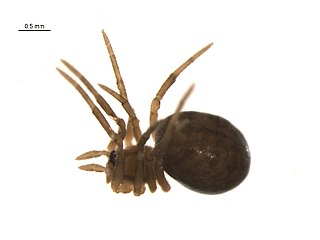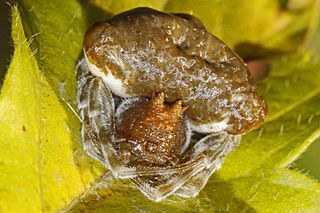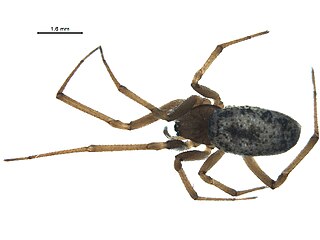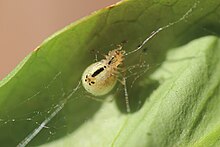Commoris is a genus of Caribbean jumping spiders that was first described by Eugène Louis Simon in 1902. As of June 2019 it contains only two species, found only in Dominica and on Guadeloupe: C. enoplognatha and C. minor.

Enoplognatha is a genus of comb-footed spiders that was first described by P. Pavesi in 1880. They have both a large colulus and a subspherical abdomen. Males usually have enlarged chelicerae. It is considered a senior synonym of Symopagia.
Paratheridula is a monotypic genus of comb-footed spiders containing the single species, Paratheridula perniciosa. The sole species was first described in 1886 under the name Theridion perniciosum. The genus was first described by Herbert Walter Levi in 1957, though it has been described under several different names, including Mysmena 4-maculata, Theridion quadrimaculatum, and Theridion arcadicum,

Rugathodes is a genus of comb-footed spiders that was first described by Allan Frost Archer in 1950. It is closely related to members of Theridion and Wamba.

Enoplognatha thoracica is a spider species with Holarctic distribution. It is notably found in Lithuania.
Enoplognatha oreophila, is a species of spider of the genus Enoplognatha. It is endemic to Sri Lanka.

Phylloneta is a genus of comb-footed spiders formerly considered a sub-genus of Allotheridion, and raised to genus status in 2008. The type species was first described by Eugen von Keyserling in 1884 as Theridion pictipes. As of September 2019 it contains three species and two subspecies with a holarctic distribution: P. impressa, P. pictipes, P. sisyphia, P. s. foliifera, and P. s. torandae.

Enoplognatha intrepida is a spider in the family Theridiidae, in the infraorder Araneomorphae . The distribution range of Enoplognatha intrepida includes the USA, Canada, Greenland, and Korea.

Enoplognatha caricis is a species of cobweb spider in the family Theridiidae. It is found in Europe, Turkey, a range within Russia, China, Korea, and Japan.
Enoplognatha marmorata, the marbled cobweb spider, is a species of cobweb spider in the family Theridiidae. It is found in North America.
Didineis latimana is a species of wasp in the family Crabronidae. It is found in North America.
Didineis is a genus of wasps in the family Crabronidae. There are more than 20 described species in Didineis.

Trachelas tranquillus, the broad-faced sac spider, is a species of true spider in the family Trachelidae. It is found in the United States and Canada.
Herpyllus cockerelli is a species of ground spider in the family Gnaphosidae. It is found in the United States and Mexico.
Tibellus maritimus is a species of running crab spider in the family Philodromidae. It is found in North America, Europe, Caucasus, Russia, Central Asia, and China.

Mastophora phrynosoma is a species of orb weaver in the spider family Araneidae. It is found in the United States. Like all known species of the genus Mastophora, adult females are bolas spiders, capturing their prey with one or more sticky drops at the end of a single line of silk rather than in a web. Males and juvenile females capture their prey directly with their legs.
Pocadicnemis pumila is a species of dwarf spider in the family Linyphiidae. It is found in North America, Europe, Turkey, Caucasus, a range from Russia, and Japan.
Metazygia wittfeldae is a species of orb weaver in the spider family Araneidae. It is found in a range from the United States to Costa Rica.

Enoplognatha joshua is a species of cobweb spider in the family Theridiidae. It is found in the United States.









